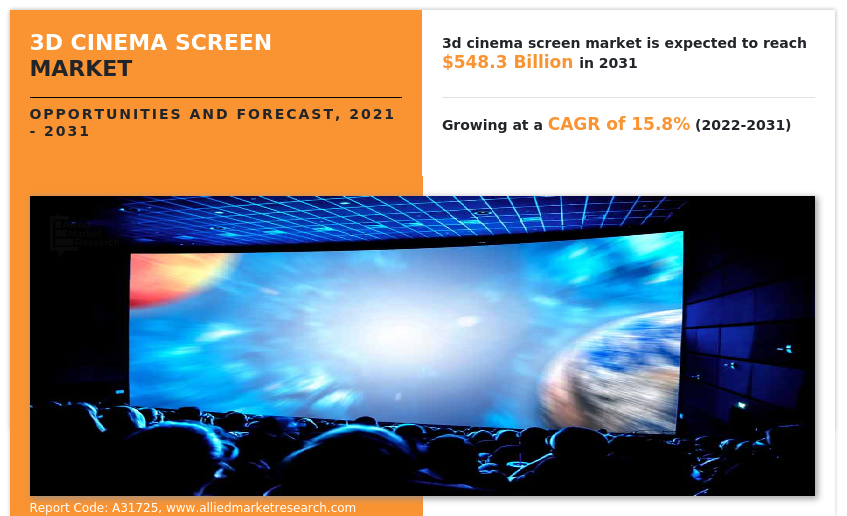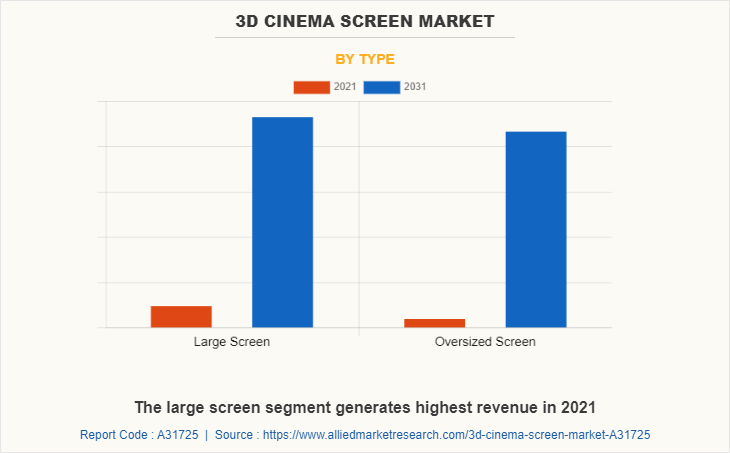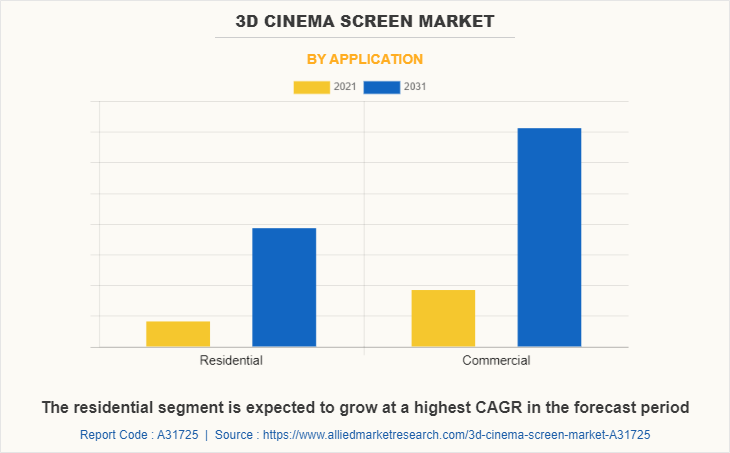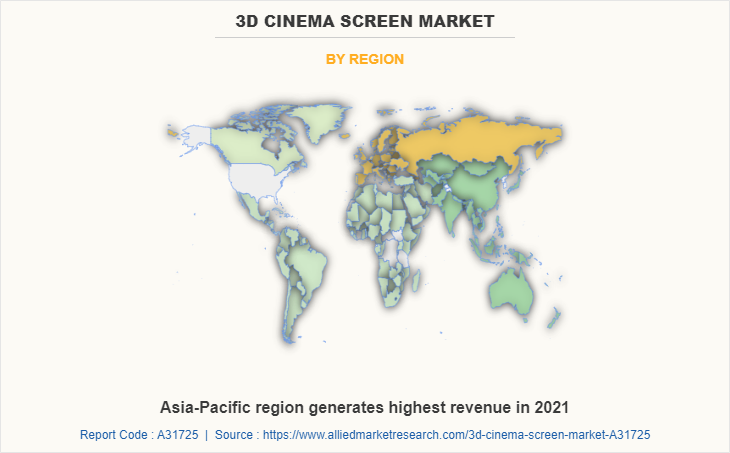3D Cinema Screen Market Statistics - 2031
The global 3d cinema screen market was valued at $132.7 billion in 2021 and is projected to reach $548.3 billion by 2031, growing at a CAGR of 15.8% from 2022 to 2031.
A stereoscopic display, often known as a three-dimensional cinema screen, is a type of flat panel display that simultaneously shows images for the left and right eyes. The illusion of depth perception is created as a result. The most popular way to achieve this effect is by using polarized filters, which are set to individually allow light only when viewed at an angle perpendicular to their orientation on the viewer's eyes.

3D movies are becoming more popular nowadays, and audiences willing to watch a 3D cinema need to wear bulky spectacles to enjoy the movie. The market expansion of 3D cinema screens is being influenced by the increase in the use of augmented reality and virtual reality, which is improving the visualization of the 3D cinema screen and leveraging digital age technologies like Artificial Intelligence (AI) and Machine Learning (ML). All of these, together with connected devices like head-mounted displays and headsets, are improving the cinematic experience. The use of Active Matrix Organic Light-Emitting Diode (AMOLED) in technologies to improve flexible display technology is increasingly a digital reality.
Despite technological developments, 3D cinema screens are still somewhat expensive, and many require additional infrastructure development in theaters such as adjustment of seating arrangement. Also, viewers must be at a particular distance from the screen for the best experience, and the display must span a wide field of vision to accommodate all spectator positions, resulting in inescapable compromises with spatial or angular resolutions which are projected to hamper the growth of 3D cinema screen market outlook during the forecast period.
The entertainment sector has expanded significantly over the past few years. The industry's trend in cinema screens has been one of ongoing evolution, with each invention aiming to provide a more natural and lifelike visual experience for the spectator. The production of 3D consumer products has increased owing to the rise in the construction of 3D movie theaters. 3D television transmission is to be the next technological advancement step in generating a more advanced visual home entertainment experience with the use of 3D technology. All these factors are anticipated to create several growth opportunities for the major players operating in the market in the future.
The industry players are investing a lot of effort in the R&D of smart and unique strategies to sustain their growth in the market. These strategies include product launches, mergers & acquisitions, collaborations, partnerships, and refurbishing of existing technology. In December 2022, RealD Inc., a leader in global visual technology, announced a collaboration with PVR Cinemas to install RealD 3D technology on at least 100 movie screens in PVR Cinemas theatres across India.
Segment Overview
The 3D cinema screen market is segmented based on type, application, and region. By type, the market is divided into large screen and oversized screen. By application, the market is classified into residential and commercial. By region, the market is analyzed across North America, Europe, Asia-Pacific, and LAMEA.
By type, the large screen sub-segment dominated the market in 2021. A large screen was created to be installed in a theatre or similar location. The largest screens measure 22 m, or roughly 20:11. They can be fixed-frame screens like those used in traditional movie theatres, which conceal the projector equipment behind the screen, or integral projection systems, which project onto the surface from both behind and above the cinema screen. These are predicted to be the major factors driving the 3D cinema screen market size.
The oversized screen sub-segment accounted for the fastest growth in 2021. A film projector that projects images larger and more detailed than standard-sized displays is known as an oversized screen. The oversized screen is most commonly used in 3D movie theaters, auditoriums, arenas, and other large venues. They have the apparent advantage of improved image clarity owing to the oversized screen’s wide viewing angle.

By application, the commercial sub-segment dominated the global 3D cinema screen market share in 2021. The oversized screen is widely used in commercial applications such as in airports and shopping malls to display advertisements in 3D format. For instance, major brands throughout the world have welcomed 3D digital displays, particularly because they give perspective and depth to their marketing and promotion channels.

By region, Asia-Pacific dominated the global market in 2021. The dominance of the cinema sector can be attributed to the region's comparatively well-established film industry and large audience base for both regional as well as international cinemas. In cinema making, cutting-edge 3D technology is being used more frequently. The region's rapidly growing 3D cinema screen industry is probably being driven by an increase in the number of 3D movie theaters in the region, particularly in China and India. Also, the increase in the production of 3D films in the region is anticipated to boost the 3D cinema screen market opportunity.

Competitive Analysis
The key players profiled in this report include Harkness Screen, Galalite Screens, EKRAN, Severtson Screen, Samsung, Ballantyne Strong, IMAX, Sony, and RealID Inc.
Covid 19 Impact Analysis
- The COVID-19 pandemic negatively impacted the 3D cinema screen industry. Multiplexes and movie theatres had been closed as the shooting was halted, and film releases were postponed during the pandemic.
- The COVID-19 pandemic has brought several uncertainties leading to severe economic losses as various businesses across the world were standstill. This has ultimately lowered the demand for 3D cinema screens due to the closure of cinema theaters and the delay in the release of movies due to the COVID-19 pandemic restrictions.
- Sales of 3D cinema screens are directly proportional to the demand from end-use industries namely cinema halls, large venues, shopping centers, auditoriums, and others. However, the demand for 3D cinema screens in cinema halls, large venues, shopping centers, and auditoriums was greatly affected owing to import-export restrictions, closed borders, and supply chain disruptions due to the outbreak of COVID-19.
Highlights of the Report
- The report provides an exclusive and comprehensive analysis of the global 3D cinema screen market trends along with the 3D cinema screen market forecast
- The report elucidates the 3D cinema screen market opportunity along with key drivers, and restraints of the market. It is a compilation of detailed information, inputs from industry participants and industry experts across the value chain, and quantitative and qualitative assessments by industry analysts.
- Porter’s five forces analysis helps analyze the potential of the buyers & suppliers and the competitive scenario of the market for strategy-building
- The report entailing the 3D cinema screen market analysis maps the qualitative sway of various industry factors on market segments as well as geographies
- The data in this report aims at market dynamics, trends, and developments affecting the 3D cinema screen market growth
Key Benefits for Stakeholders
- This report provides a quantitative analysis of the market segments, current trends, estimations, and dynamics of the 3d cinema screen market analysis from 2021 to 2031 to identify the prevailing 3d cinema screen market opportunities.
- The market research is offered along with information related to key drivers, restraints, and opportunities.
- Porter's five forces analysis highlights the potency of buyers and suppliers to enable stakeholders to make profit-oriented business decisions and strengthen their supplier-buyer network.
- An in-depth analysis of the 3d cinema screen market segmentation assists in determining the prevailing market opportunities.
- Major countries in each region are mapped according to their revenue contribution to the global market.
- Market player positioning facilitates benchmarking and provides a clear understanding of the present position of the market players.
- The report includes an analysis of the regional as well as global 3d cinema screen market trends, key players, market segments, application areas, and market growth strategies.
3D Cinema Screen Market Report Highlights
| Aspects | Details |
| Market Size By 2031 | USD 548.3 billion |
| Growth Rate | CAGR of 15.8% |
| Forecast period | 2021 - 2031 |
| Report Pages | 260 |
| By Type |
|
| By Application |
|
| By Region |
|
| Key Market Players | Ballantyne Strong, Severtson Screen, IMAX Corporation, Sony Corporation, Samsung Electronics Co Ltd, Galalite Screens, ekran system, harkness screens |
Analyst Review
The increase in demand for 3D cinema screens from cinema theaters and the film industry to provide viewers with a real-time experience is the key factor that is projected to drive the market growth. In addition, the increase in the use of 3D technology in filmmaking enhances the overall experience which is driving the market expansion. Also, the growing application 0f OLED technologies, which provides superior picture quality and improved viewer experience when compared to conventional cinema screens is anticipated to boost the market expansion. People who have mono-eyed or who have perception in their left and right eyes cannot see the 3D content. Also, 3D cinema screens are expensive and require some calibration before it gives the required results. These are the factors expected to hamper the 3D cinema screen market share during the forecast period. The technological development in the field of 3D cinema screens such as the use of automultiscopic display technology eliminates the requirement for 3D glasses. This is the major factor anticipated to provide growth opportunities for key players operating in the 3D cinema screen market in the upcoming years.
Among the analyzed regions, Asia-Pacific is expected to account for the highest revenue in the market by the end of 2031, followed by North America Europe, and LAMEA. The growing popularity of 3D movies, rising disposable income, and the increasing demand for an immersive movie-watching experience are the key factors responsible for the leading position of Asia-Pacific in the 3D cinema screen market.
The rise in the use of 3D technology in the film industry and changing customer preference towards 3D films are estimated to generate excellent opportunities in the 3D cinema screen market.
Asia-Pacific will provide more business opportunities for the global 3D cinema screen market in the future.
The major growth strategies adopted by the 3D cinema screen market players are investment and agreement.
Harkness Screen, Galalite Screens, EKRAN, Severtson Screen, Samsung, Ballantyne Strong, IMAX, Sony, and RealID Inc. are the major players in the 3D cinema screen market.
The commercial sub-segment of the application acquired the maximum share of the global 3D cinema screen market in 2021.
Cinema theatres, filmmakers, and event organizers are the major customers in the global 3D cinema screen market.
The report provides an extensive qualitative and quantitative analysis of the current trends and future estimations of the global 3D cinema screen market from 2021 to 2031 to determine the prevailing opportunities.
The use of 3D cinema screens in cinema theatres, auditoriums, stadiums, and others is estimated to drive the adoption of the 3D cinema screen.
Loading Table Of Content...



